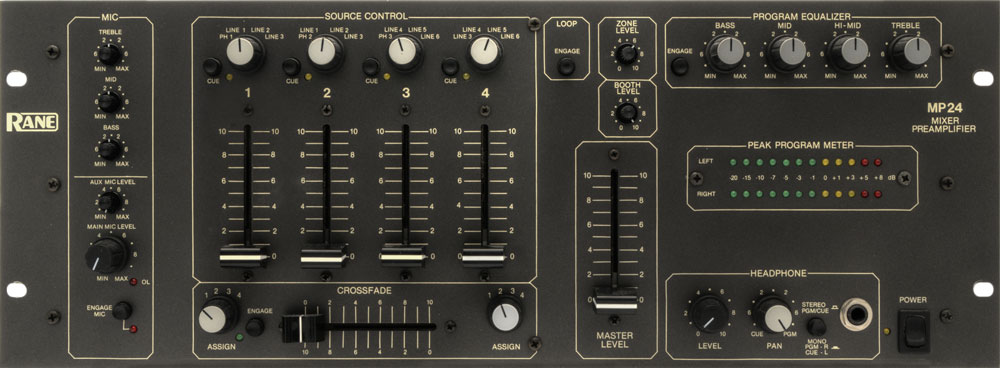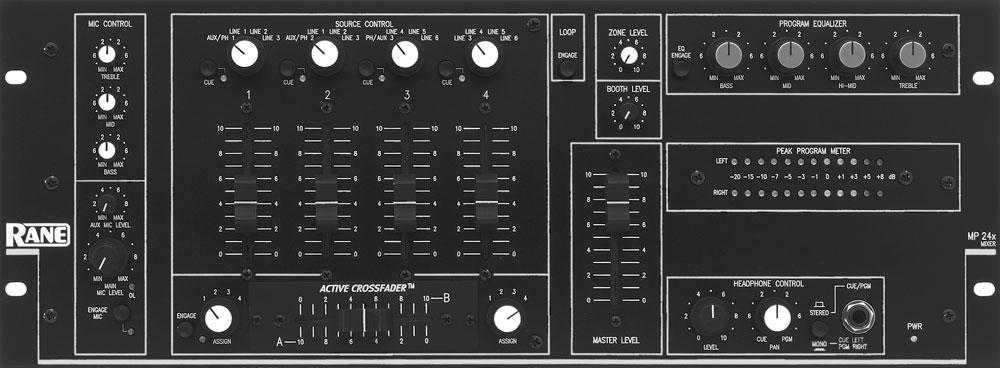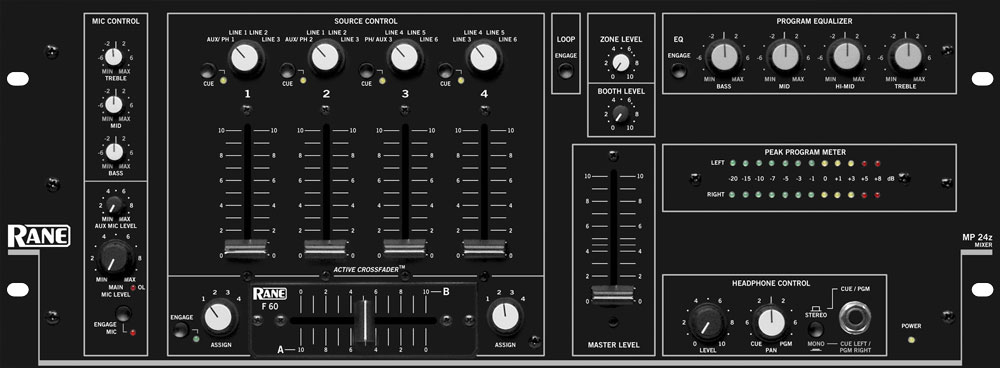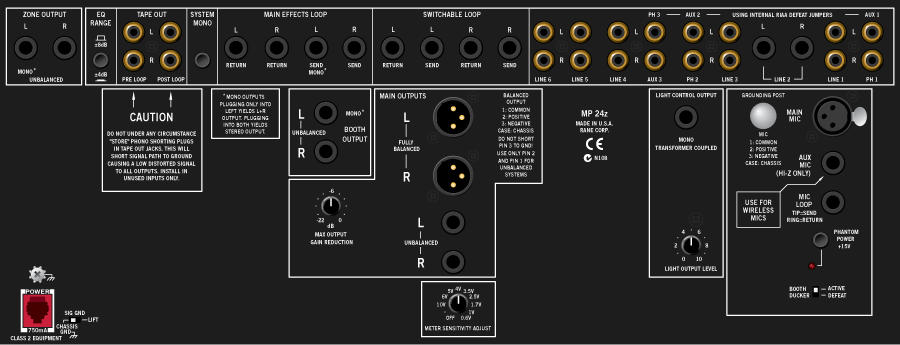MP 24: A DJ Mixer Evolution
General History
Rane first entered the DJ mixer market upon request from Richard Long of Richard Long & Associates
(RLA). Richard Long was a famous sound designer for the biggest names in disco. He designed systems
for Studio 54, Annabels (London), Regines (a chain of 19 clubs scattered around the world from Paris
and New York to Cairo) and many others that were the vanguard of the disco era.
Richard approached Rane and asked them to redesign his famous X3000 crossover using their
proprietary technology. This became the X3000A, built exclusively for Richard Long. They also codesigned
a DJ equalizer called the Q5000. Based on his successful relationship with Rane, he persuaded
them to research the DJ mixer market. They did and produced their first DJ mixer, the MP24 which
rapidly became the industry standard, installed in clubs around the world for almost 20 years.
Functionality issues on the MP 24 series vary widely. The original MP 24 did not have a switchable booth output ducker, nor could the output level be adjusted as much. These features received immediate attention. The MP 24x is the first version to use the VCA controlled Active Crossfader assembly. The "x" and "z" type crossfaders are not interchangeable. See the Crossfader Replacement Chart for applications and part numbers. The "constant power" (dip in the middle) crossfader circuit cannot be changed to that used later in "z" version.
Original MP 24 Spring 1986 to early 1994

From the front:
- Power switch, no plug-in crossfader, old gray-brown color.
- Earliest units have smaller shiny plastic knobs on all six slide pots.
- Most units shipped with hex (Allen wrench) head screws holding front panel hardware in place.
- Replacement front panels are no longer available.
From the rear:
- 3-prong AC power cord or a black RJ 12 (looks like a telephone jack) DC 24 volt power jack on some units.
- Serial numbers are MP.xxxx format, with four digits only, (FAQ describes serial number details).
- Date Code is on separate vinyl silver sticker, using X-YY format (X is QUARTER and Y is YEAR).
MP 24 Remote AC Power Spring 1994 to Fall 1997
From the front:
- No power switch
- Plug-in crossfader (on all models from this era forward)
- Shipped in dark-gray color originally, later in black.
- Replacement front panels are no longer available.
From the rear:
- No attached AC line cord
- Uses red RJ 12 power connector (looks like a telephone jack).
- Uses external power supply called the RS 1. All MP 24 mixers, from this version on, are powered by this supply.
- "PH 3, AUX 2 and AUX 1" jumper options listed above RCA input jacks.
Inside the unit:
- All versions from now on have internal programming jumpers, so users can change Phono Inputs to Lines as well as configuring other signal routing for Zone and Tape outputs.
MP 24x Fall 1997 to Spring 1999

From the front:
- Black chassis.
- Has "MP 24x" silk screened on face.
- Dual color silk screen on input selectors.
- Crossfader knob is same type as used on Input faders, black only.
- Crossfader panel says "Active Crossfader" in white print across center of metal plate.
From the rear:
- Red RJ 12 power connector (looks like a telephone jack).
- Has "MP 24x" silk screened on rear chassis. Jumper options silk screened above RCA input jacks.
- Last silver vinyl serial numbers used in 9-99. White bar-code sticker, located on side of unit, used 10-99 onward.
- Serial numbers from 10-99 comprised of (21) xxxxxxxx (example: 00123456, [not a valid MP 24 serial number]).
Inside the unit:
- All MP 24s now utilize the Active Crossfader meaning the audio is routed through a VCA for better performance and much longer crossfader life span. Crossfader circuit is Constant Power, which results in the notorious "dip in the middle" response.
MP 24z Spring 1999 to Summer 2006 (two versions exist)

From the front:
- Black chassis.
- Has "MP 24z" silk screened on face
- Small tapered crossfader larger dished bus fader knobs on first version, current version has smaller tapered knobs on all slide controls.
- Crossfader panel has "F 60" in white print on upper corner of metal plate.
- From Fall 2002 Input faders are monorail type; the same used for in the F 60 crossfader.
From the rear:
- Red RJ 12 power connector
- Has "MP 24z" silk screened on rear chassis.
- Jumper options silk screened above RCA input jacks.
Inside the unit:
- Crossfader circuitry is no longer Constant Power.
- Crossfader halfway (in center position) does not attenuate either bus signal.
- F 60 (F 45 is optional) .
- F 60 (alternately F 45) crossfader assembly plugs in with six-wire ribbon cable assembly.

Interesting things MP 24 mixers have done or been exposed to
An MP 24 came in with a bullet hole in its rear
chassis once, from a .22 going off in a night club. It still worked when
it arrived.
We got a mixer back that had been smashed repeatedly (read fit of rage) with a crow bar. Although the front panel was
very bent the mixer worked, but the faders were difficult to adjust.
A guy tried to fix a hum in his sound system
using a "cheater adapter" on his MP 24 line cord; the channel four circuit
board melted and the mixer was destroyed. He later found out the club had
"improper" AC wiring. Ya think?!
The MP 24 is the longest continually produced
DJ mixer on the planet. The UREI 1620 had the record for many years. First MP 24 shipped September 8th, 1986; it's serial MP1002.
A customer stripped his older color front panel
down to bare metal, had it re-painted black then paid substantial money
to have it re-silk screened. Over five years later Rane changed all products
to black color. Maybe this guy was clairvoyant.
On more than one occasion, an MP 24 has frantically been shipped back to the factory after champagne was spilled in it -- must have been a festive wedding reception -- just to arrive "dried out" and functioning correctly. We cleaned and tested each of them, just to be sure.
A few MP 24s have survived automobile accidents,
with damage ranging from sheared front panels, to almost every control
snapped off. We've been able to successfully restore all subjected to this
torture, so far.
The first MP 24 was originally designed for broadcast and production applications, not club installs. We designed it "so sturdy," becoming the
industry standard was to be expected.
The last MP 24z was built and shipped on July 31, 2006. It didn't quite make its 20th birthday. Its demise came from lead-free solder requirements in the EU. Existing MP 24s will continue to entertain for many, many years.
Rane DJ Blog Article: Rane's First DJ Mixer: The MP 24
 PDF Manuals for discontinued products are found here. PDF Manuals for discontinued products are found here.
 RaneNote "Evolution of the DJ Crossfader" RaneNote "Evolution of the DJ Crossfader"
|